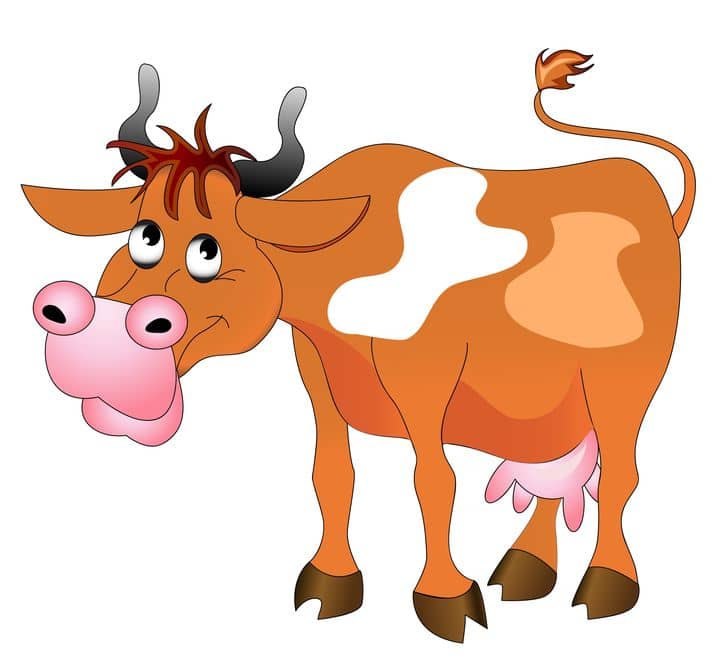You may have heard about grass-fed beef and how good it is in both taste and nutrition, but don’t all cows eat grass? They have been for years, right? Well, actually all cows start out their lives eating grass, but not all end up eating grass. Due to the massive amount of beef today being manufactured, most cows are grain-fed for the last 2/3 of their lives. Due to this mass production of beef, what are the benefits of grass-fed vs. grain-fed beef?
You may believe that grass-fed means the cow has been fed grass all of its life. Actually grass-fed means that the cow was fed anything that is in the pasture including grass, herbs, clover, and wildflowers, at the beginning of its life, but not necessarily its whole life. This is where this can get dicey.
The term “grass-fed” is not a regulated term. Completely grass-fed throughout its life would actually be labeled as “grass-finished.” So be aware when purchasing something that says it is grass-fed. It may not be completely that way.
Grain-fed beef means that the cows start off feeding on their mother’s milk and grass and other plants, but then are transitioned to grain feedlots for the remainder of their lives. In these feedlots, they are fed different grains and corn in order to get them fatter sooner so they get to the butcher faster than a grass-fed cow would. As these cows are fatter, you will see more fat/marbling in the meat resulting in a juicier cut of meat.
We have some information to help you determine any benefits of grass-fed beef vs. grain-fed beef. They both definitely have their pros and cons.
The Difference in Taste Between Grass-Fed and Grain-Fed Beef
There would be a difference in the taste of grass-fed vs. grain-fed beef due to the fact that what the cattle eat translates to the way the beef will taste.
Grass-Fed
When cattle are grass-fed, they don’t produce as much internal fat. Therefore, you won’t have the marbling in the meat that is the fat that produces the flavor. Some have said that they notice a grass taste in their burgers, or even a meaty, game-like taste.
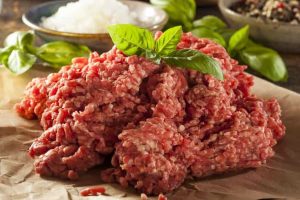
But they have enough fat to give the beef its good flavor. Cows feed on greens other than just grass. They are foraging on plants and bushes, basically, anything growing out of the ground. So what does what they are eating do to what you ultimately eat?
- Flavor in the beef is a result of what the cattle eat. The flavor of the fat in grass-fed comes from the nutrients in the grasses they are eating.
- Plants and grass contain vitamins and minerals so when consumed by the cattle, these nutrients transfer to humans through their meat.
- Grass-fed can have different tastes depending on the pasture in which they were grazing. You are not going to know what farm your beef is coming from, but be aware of the different tastes you might experience. If the cattle grazed on a variety of grasses, they will have a different taste than if they were grazing on a more mature pasture.
- Taste can also be different depending on the time of year the cow was butchered. A cow butchered in the winter will probably have more fat due to keeping warm thereby providing a different flavor.
Grain Fed
When cattle are fed grains many of those grains can create more fat in the beef and give it a somewhat sweeter taste. Grain-fed beef contains more fat so you are going to have more flavor and it won’t be as dry as grass-fed.
- A burger made using grain-fed beef has also been described as buttery, more marbling and juicier, rich flavored.
- Some of the types of grain cows are fed are corn, barley, and soy. Corn leads to higher levels of marbling and gives the meat a sweeter taste.
- Did you know that cattle begin their lives eating grass, but then are transferred after about six months to a feedlot to grain feed? With a grain diet, the cattle grow faster and, therefore, gets them to the butcher sooner.
Nutrition Information
According to the US National Library of Medicine, it is noted that research spanning over three decades has found that cows that are grass-fed do have improved fatty acids and antioxidant content in the beef. They are also found to be lower in their fat content, which is important to those who are concerned about their fat consumption.
Also, grass-fed has been shown to contain more omega-3 fatty acids, which lend themselves to being more heart-healthy. They also contain more antioxidants including vitamin E that protects the body from free radicals that damage the body’s cells.
Grass-fed beef has lower levels of saturated fat than grain-fed beef. Saturated fats can cause higher cholesterol in your body raising your bad cholesterol.
Nutrients in what we eat affect how our bodies function. This is no different in what cows are eating. If they are eating grass the fat in their bodies, which gives us the flavor in our burgers, becomes a dark yellow due to the beta-carotene that is contained in grass. This is an antioxidant which is another item good to fight free radicals in our bodies.
Grass-fed contains more omega-3 fatty acids than grain-fed. These fatty acids help reduce triglycerides and omega-3’s are anti-inflammatories. However, both grass-fed and grain-fed beef contain omega-6 fatty acids, which are essential for energy and helpful in treating certain disease symptoms.
Grass-fed beef also contains higher amounts of Vitamin A and E than grain-fed.
Grass-fed contains more omega-3 fatty acids so it does have a higher nutritional value. Due to the smaller fat content, you also experience fewer calories in grass-fed.
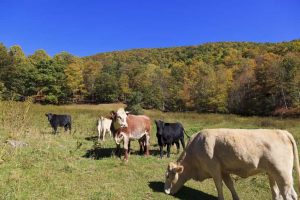
You do need to be aware that grass-fed is not a regulated term and does not necessarily mean that the cattle were fed a grass diet their whole life, which is what grass-fed should mean. If the cattle were fed a grass diet all of their lives, then the package would say grass-finished.
While all of these things are worth taking into consideration, beefmagazine.com states that there is truly no difference in the healthfulness between grass-fed and grain-fed beef. But take a look and make that determination for yourself. It truly is up to you.
The diet of the grain-fed cows includes grains such as barley that don’t contain the nutrients that are in the pasture-raised cattle.
Grain-fed beef is given antibiotics, but not for growth. As regulated by the FDS they are only given antibiotics are given under a licensed veterinarian.
Grain-fed beef has been found to be lower in saturated and trans fats than grass-fed beef. These fats have been shown to be bad for heart health and added to the increase of bad cholesterol.
Grain-fed contains more oleic acid than grass-fed. Oleic acid is an omega-9 fatty acid that is unsaturated fat that has health benefits such as enhancement in brain function, helpful to those with type 2 diabetes, and helps support weight management.
The time it takes for grass-fed cows to be ready for butchering is about a year longer than a grain-fed cow. This creates a longer time that farmers have to care for the cows resulting in the higher price of the meat. Since grain-fed cattle are to butcher earlier, the cost of the meat is less to you.
Grain-fed has more of the fat marbling giving it a richer, juicier taste in the meat. Fat does equal flavor.
Texture Difference in Grass-Fed vs. Grain-Fed Beef
Since grass-fed beef is leaner with less fat, many feel it is drier and chewier due to the less marbling cut of the beef. Because of this lack of marbling, you don’t have the amount of fat that gives it the texture and flavor. You may also experience a type of grainy texture with grass-fed.
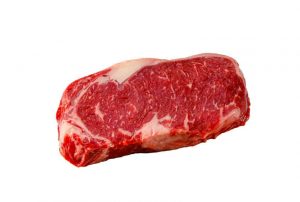
Along with the grass-like taste, grass-fed is also described as meaty or gamey. The texture of grass-fed can also depend on where the cows were raised and the types of grasses they were exposed to.
The texture can also be determined by how old the cow was and the breed of the cattle. Other factors that can attribute to the texture of the beef is how it was butchered and the genetics of the animal.
Grain-fed beef is richer in texture due again to the fat. You will see more of the fat marbling in the texture of grain-fed beef. The meat will also be more tender due to this extra fat.
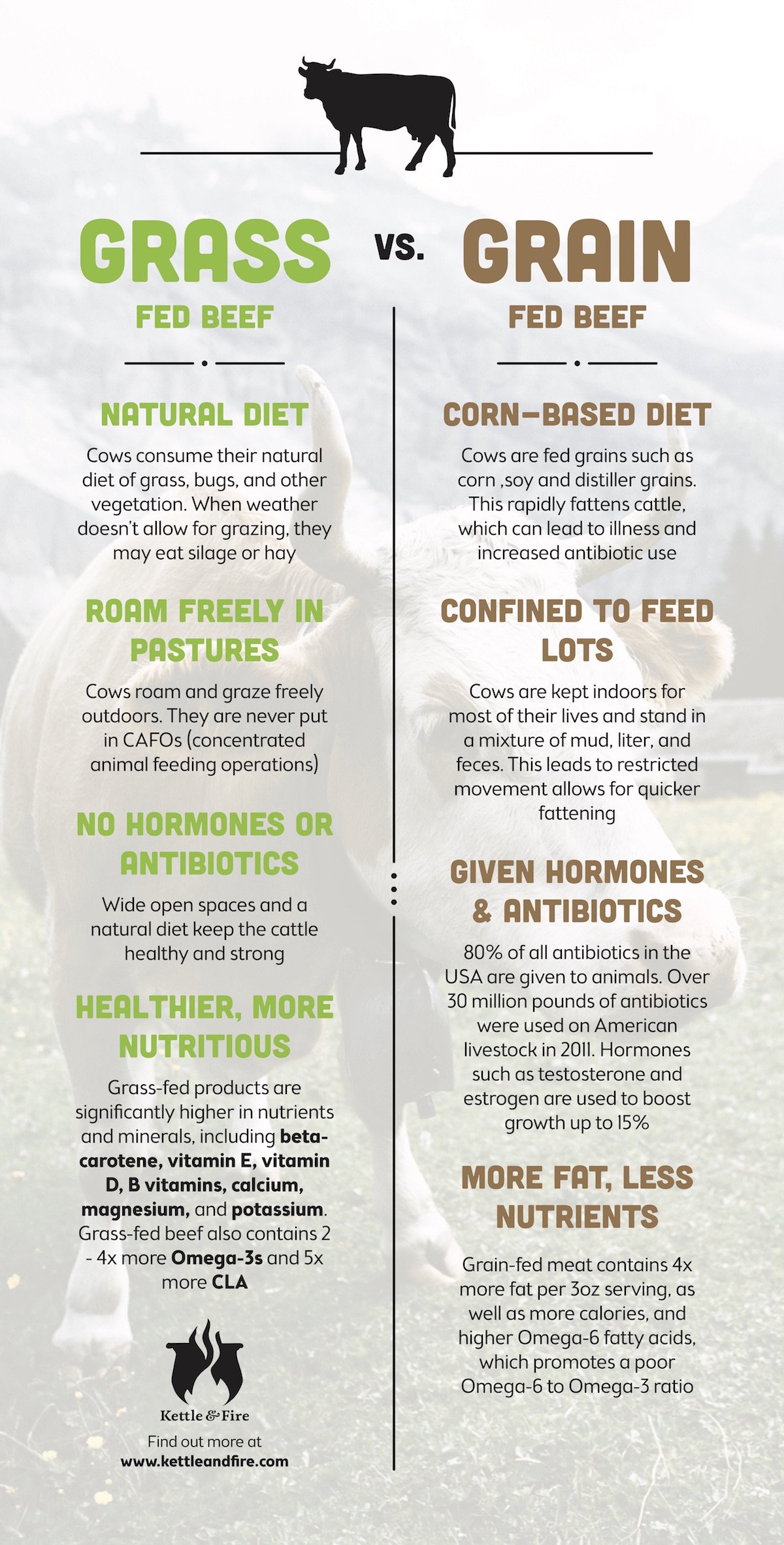
What is the Price Difference Between Grass-Fed and Grain-Fed Beef?
Grass-fed beef is going to be more expensive than grain-fed. You might find it up to $4 more per pound than the grain-fed. They will also weigh less than grain-fed as the corn bulks up their diet.
According to Consumer Reports, grass-fed beef is higher priced due to the length of time it takes for the cattle to be ready to go to be processed. As the cows are eating grass and other plants, it takes them longer to reach processing weight. Due to this lag in time that the farmers have to wait and the extra care it takes during this time frame, the farmers have to recoup their costs.
Is using grass-fed worth the extra cost? If you are all about fewer calories and increased nutrients in the meat, then yes it is for you. But you have to be aware of the difference in the taste and texture.
Due to some people believing there is really no difference in the taste of each and aren’t too concerned about the difference in the nutritional values, they would probably opt for purchasing the regular grain-fed beef.
But ultimately it is up to you as to whether or not the difference in the cost for grass-fed beef is worth it for the taste and texture of the meat.
Conclusion
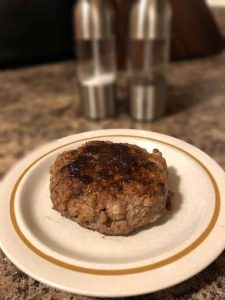
To determine the benefits of grass-fed beef vs. grain-fed beef, you have to decide what you want to use to make your hamburgers, you have to consider the taste you end up with when using each one and what that taste is that you are looking for. You also want to consider what else is important to you, such as the nutrient factor and the cost.
We do want you to be aware of the difference in when the label shows grass-fed or grass-finished. Grass-fed means that the cattle were raised on grass at some point in their lives, but not necessarily their whole lives. This term is not a regulated term. If the label says “grain-finished,” this does mean that the cattle were pasture-raised their entire lives before going to butcher.
With grass-fed you will most likely get that taste you are looking for, but we want you to be aware that there may have been grain-fed to the cattle at some point.
Let us know what your preference is for the meat you want to use when cooking your burgers. We love to know your thoughts and insights.

